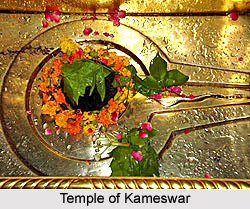 The temple of Kameswar located in the northern division of Varanasi is a famous pilgrimage centre. The temple is regarded as very holy and is visited by many devotees. The idol here, Lord Kameswar is believed to fulfil the desires and requirements of his devotees.
The temple of Kameswar located in the northern division of Varanasi is a famous pilgrimage centre. The temple is regarded as very holy and is visited by many devotees. The idol here, Lord Kameswar is believed to fulfil the desires and requirements of his devotees.
Legend of Temple of Kameswar
According to the legend of Temple of Kameswar Rishi Durvasa was once travelling and reached Varanasi. Here he dug a kund for taking his bath. He also installed an idol of Lord Shiva in the vicinity for worshipping him. One day for some reasons he got angry and cursed the city and its people. Lord Shiva appeared before him. Durvasa immediately lost his temper. The sage then requested him that the kund he had developed must be named as Kamkund and the idol that he installed must be known as Kameswar. The Lord blessed him and granted him the boon. The Lord also told him that when Saturday, Trayodashi i.e. on the 13th day after Amavasya or Purnima coincides with the Pradosha day any one taking bath in the kund would be relieved of his sins and his wishes will be fulfilled.
Architecture of Temple of Kameswar
At the entrance of the passage a temple has been erected that houses several deities. Passing through that one reaches the first court. It has a kettledrum that is beaten at various intervals during the day in honour of the presiding divinity. The second court in the quadrangle is completely occupied with temples. The place however looks very congested as the quadrangle is not very spacious. Here all the temples are painted in red colour. The main temple is dedicated to Kamnanath, or Kameswar, the Lord of Desire. There are two Lingas in the temple. The bigger Linga is known as Durvasa Linga and the smaller Linga is known as Kameswar Linga. The Durvasa Linga symbolises Bhakti and the Kameswar Linga is symbolic of Shakti. The According to Hindu belief the Lord helps his worshippers in the realization of whatever they aspire to achieve. Another temple is inhabited by the Lord Rama and his wife Sita, Goddess Lakshmi, and the Lord Surya. There are altogether ten or a dozen temples here, each housing several idols.
On the north side of the enclosure is a peepul tree that is surrounded at the base by a platform. A group of idols can be seen here. One of these is Lord Narasimha, an incarnation of Lord Vishnu. As per the legend it is said that the birth of the Lord was from a pillar that was split down from the middle. The two parts of the pillar have been represented in the stone figure on either side of the idol. It has been shown in the form of a man having two horns on his head and sitting in between the divided pillar. He is seen gloating over the victim which is Hiranyakashipu who lies prostrate across his lap. The demon here mercilessly tears the victim with his nails and greedily drinks his blood. Apart from these there is another idol of Lord Shiva with a snake creeping up it. Beside the idol there is a stone on which are carved ten other idols. Long narrow rooms can be seen on the sides of the quadrangle that open on the centre of the square. These rooms house several groups of deities. Two of these are occupied by idols of Lord Shiva. In one of the rooms there are almost twenty-five idols. The third room has the idol of Narasimha and also the goddess Machaudari, an immodest figure, seated on a peacock. In the same room there is also an image of the Rishi Durvasa.
The temple of Kamananath is connected with a plain which was formerly an extensive jhil or pond. It was earlier known as Machaudari Teerth. This was an also a centre of pilgrimage and was visited by many pilgrims who come here to worship the Lord.





















